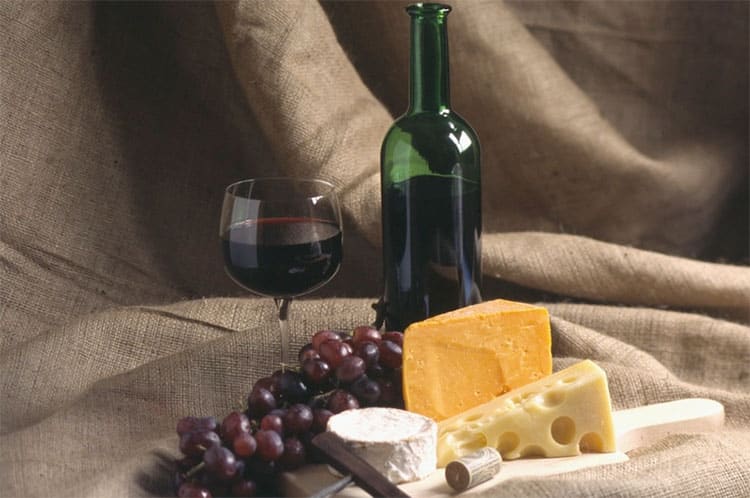• by Carri L. Wroblewski, BRIX Wine Shop •
It’s September, the big crowds have returned home, and once again we reclaim the island after a bustling summer. For all of the entertaining that we helped other people do in July and August, it’s time for us to kick back, relax, and have a party of our own.
But the key word is relax and after a long summer we want to keep it simple, invite our friends over that we haven’t seen in two months, and catch up. So toss aside your elaborate menus, give the grill a break, and grab some wine and cheese for a simple, yet mouth-watering evening.
But, where do you begin and how do you know what cheese pairs with what wine?
Start with one easy question: are they made for each other? One of the most challenging things about pairing wine and cheese together is that there are so many different types of cheese and so many varying styles of wine. Cheeses can differ in texture, fat content, and flavor while wines have a range of acidity, tannins, sweetness, and body. How do you play matchmaker and assure your pairings go off without a hitch? Here are some tasty tips to successfully marry the flavors of two of life’s most delicious pleasures.
If It Grows Together, It Goes Together
One of my wine consultants in Boston introduced me to this phrase a number of years ago, and not only do I love it, I reference it often. The easiest way to think about it is pairing wine and cheese by the region they come from. For instance, think about the combination of a fresh goat’s milk cheese from France’s Loire Valley paired with a Loire Valley Sancerre or Pouilly Fumé. The acidity, minerality, and grassy notes of the Sauvignon Blanc are the perfect companion to the tang of the goat’s milk cheese. Another popular regional pairing is that of Manchego and Rioja. Spain’s most popular sheep’s milk cheese sings when quaffed with a glass of fruity Tempranillo. And for a French classic try Époisses de Bourgogne, the decadent and pungent pasteurized cow’s milk round that is made in Burgundy, France, where the rind is washed with a local brandy called Marc de Bourgogne. A traditional pairing with this creamy indulgence is a red Burgundy (Pinot Noir) from the same growing area.
Texture: Two of a Kind, Opposites Attract
Some of the best pairings can be made when you put together flavor profiles that are similar to each other. And yet, contrasting flavors also create interesting combinations. A rich, creamy cheese like Camembert teamed up with a rich white wine like Chardonnay can make a seamless match and bring out the best in each other. One of my favorite “opposites attract” combos is the famous cheese Brillat-Savarin from France sipped alongside a glass of Champagne. Brillat-Savarin is a triple crème cheese named after the 18th Century epicure who once said, “Tell me what you eat, and I’ll tell you who you are.” Made from 75% butterfat this rich, creamy cheese begs to be paired with a refreshing flute of bubbles to help cut through the fat.
Taming the Tannins
Tannins in wine are the elements that give you that dry, puckering feeling in the mouth after you take a sip of wine. You find it predominantly in reds wines where it can also give you the sensation of bitterness and astringency. But choosing the right cheese to partner with that delicious bottle of red that you just opened can be trickier than you think. Because wines have varying levels of tannin and acid they can compete with different flavors of cheese. Big, tannic red wines are great counterparts to aged cheeses that have a lot of richness. The tannins cling to the fat and protein in cheese, which in turn “clean” your palate after each bite. On the flipside, pairing a tannic wine with a young cheese can leave you with an astringent flavor and an unsavory aftertaste. So if you like your reds rich, try them with aged cheddar, Compté, Pecorino, Gouda, Manchego, or Parmigiano-Reggiano.
Feeling Blue?
Just like in love, sometimes it doesn’t work out. Matching wine with blue cheese can be one of the most challenging pairings and often one of the most mismatched. Many of us naturally gravitate to red wine when we get that ripe piece of Gorgonzola Dolce or Stilton, but not so fast. Though some red wines can stand up to the bold flavors of blue cheese, it is not necessarily the ideal pairing. Blue cheese tends to be sharp, salty, and pungent. A natural combination is a wine that has a hint of sweetness, so it can balance out the saltiness of the cheese. Grab yourself a bottle of Sauternes, tawny port, Madeira, or sherry and a hunk of Fourme d’Ambert or Jasper Hill Farms Bayley Hazen Blue, and you’ll be all set. Still want to drink red? Amarone is a great go-to wine when you’re feeling like a little blue.
The bottom line—wine changes the way cheese tastes and cheese changes the way wine tastes. The simple introduction of another flavor on either end can send your palate in a different direction. But pairing them together doesn’t have to be complicated and these are just tips, not rules. So have some fun, keep it simple, open whatever wine you have on hand, and invite your friends over for some cheese. After all, no marriage is perfect.



